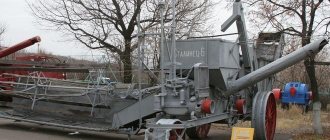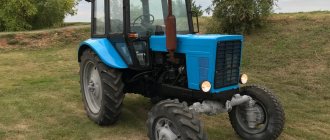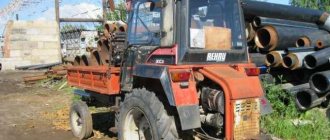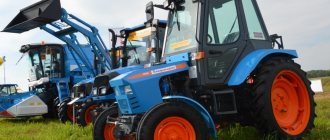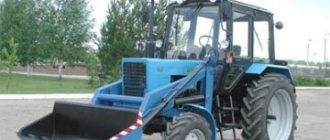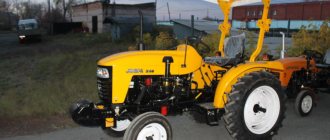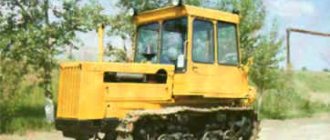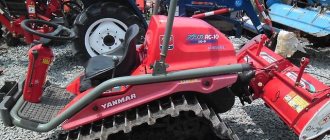Author: Alexey
22 February 2022 10:12
Tags: OTZ Tractors history
9355
17
On January 30, 1956, by the Decree of the Council of Ministers of the USSR on the production of diesel skidding tractors for the forest industry, a specialized enterprise for the production of skidding diesel forest tractors was created on the basis of Onegzavod, its new name is the Onega Tractor Plant (OTZ). The first car rolled off the OTZ assembly line on June 29, 1956.
0
Source:
See all photos in the gallery
The TDT-40 tracked tractor of the 2-ton class has been produced since 1956 at the Onega Tractor Plant, and is intended for removing trees from the felling site in the forest, as well as for rafting, transport and other work. The tractor has high cross-country ability and good maneuverability and can move around the cutting area in the presence of stumps, fallen trees, difficult road conditions and poor soils. The presence of a winch and a special loading device on the tractor allows you to form a cart, load it onto the tractor shield and unload it. The TDT-40 tractor is of frame construction, with a front-mounted engine and rear-mounted drive wheels. The tractor frame consists of two side members, cross braces and a bottom. The cabin is located on the front of the frame. Water and oil cooling radiators are installed in front of the cabin. The oil radiator is mounted on the water radiator strut and is located in front of it; water - attached to the brackets of the tractor frame. A diesel engine is installed behind the radiator. The engine is mounted at three points: at the front to the frame cross member, and at the rear supports to two welded angles. The engine is covered by a hood with removable sides. The gearbox is attached to the engine flywheel housing flange. A winch and a worm gearbox are installed above it on the frame, which is driven by a chain drive from the gearbox. Behind the winch there is a loading device consisting of a shield, its front frame, a block and torsion bars. The rear axle unit, including the main gear, steering couplings and brakes with a control mechanism, as well as final drives, is attached to the rear end of the tractor frame. The transmission of force from the gearbox to the main drive shaft of the rear axle is carried out through the cardan shaft. Drive wheels with two removable rims on each are mounted on the flanges of the driven shafts of the final drives. The tractor frame with its four brackets rests on the suspension springs. The tractor's suspension is balanced, with leaf springs and includes two main balancers and four carriages with two road wheels each. The guide wheels are mounted on cranks, with the help of which the track tension is regulated. The idler wheels have a shock-absorbing device, which eliminates the risk of damage to undercarriage parts when the track is over-tensioned. The tractor tracks are fine-linked, with cast steel links made of carbon steel, strengthened by heat treatment. The tractor has four headlights: two at the front and two at the rear, which ensures the tractor can operate at night. Thanks to significant ground clearance, balance spring suspension and fine-linked tracks, the tractor has good maneuverability and high cross-country ability in various working conditions.
TDT-40M
0
The TDT-40M tractor is created on the basis of the TDT-40 tractor and is intended for skidding of small and medium-sized forests. Unlike the TDT-40 tractor, it can also be used for other forestry work. To do this, it is necessary to replace the loading device with front and rear hydraulically controlled attachments, for the installation of which installation spaces are provided. A three-spool distributor is installed in the hydraulic system for the same purpose. The TDT-40M tractor is equipped with a more powerful D-48T engine, and a hydraulic device is used to drop and shock-absorb the loading shield, which ensures shock-free loading of trees onto the shield and facilitates the work of the tractor driver. The center of gravity of the tractor is shifted forward, as a result of which the lifting of the front part of the tractor when loading a pack of trees onto the shield is reduced and better distribution of the load across the support rollers is ensured, as well as the dynamic properties of the tractor are increased. The chassis and winch have undergone significant modernization.
×
Skidder model j 65a
This model is an exact copy of the domestic TDT 40 power unit, which was discontinued at the end of the twentieth century. At the same time, all design and technological documents for the production of the model were transferred to the Chinese authorities.
Today the tractor is manufactured in China. The car has been repeatedly modernized by Chinese engineers.
In the modern market of forestry machines, the leading position is occupied by skidding units from Japanese manufacturers. They differ not only in engine power, but also in maneuverability and efficiency.
T-402
0
The T-402 tractor is created on the basis of the TDT-40M tractor and is intended for skidding trees from the cutting area, as well as for rafting, transport and other work. The T-402 tractor is a basic model for conversion to forestry, road construction and other modifications. The tractor is equipped with a 55 hp engine. and a box with a changed gear ratio, which improves the traction characteristics of the tractor. Along with the suspension being shifted back, some components (engine, cab, gearbox, winch, loading device) were moved forward, as a result of which the dynamic qualities of the tractor were further improved. The tractor is equipped with a metal cabin with ventilation. Facilitation of engine starting at low temperatures is provided by an engine and fuel heater.
Tractor model TDT 60
This model has a caterpillar drive. The tractor was developed at the Minsk design bureau, and production was launched at the tractor plant in Altai. The main tasks that a tractor must perform include: skidding, loading/unloading harvested logs.
Technical indicators:
- power 60 l. With;
- speed range 2.1/7.6 km/h;
- weight 11 t.
The power of the model allows you to work with packs of whips, the volume of which should not exceed 15 cubic meters.
T-49
0
The T-49 tracked skidding tractor of the 3-ton class has been produced since 1961 and is designed for skidding trees from the cutting area to the loading site. The presence of a front linkage system on the tractor allows it to be used for clearing trails from stumps, dead wood, snow, stacking trees, pulling out shot trees and other work. When the tractor is equipped with various mounted mechanisms, the T-49 tractor can be used as a forestry, transport or road machine. The tractor is equipped with a hydraulic release of the loading shield.
Model of the Kirov plant LT 154
This tipless model greatly facilitates the work of logging. She is able to transport packs of harvested whips, the volume of which can reach 8 cubic meters. It is also worth noting the wide temperature range in which the tractor can operate. It is equal to -40 C0 to +40 C0.
Main technical indicators of the model:
- power 130 hp;
- maximum speed 10.2 km/h;
- model dimensions d/w/h 6.8/2.7/3.9 m;
- weight 16.08 t.
The tractor has proven itself well in many domestic forestry enterprises.
T-47
0
The T-47 forestry tractor belongs to the 2-ton class of tractors and is a modification of the TDT-40 skidding tractor. Designed for plowing, cultivation, sowing, caring for forest plantings and performing other forestry work. The chassis is made the same as that of the TDT-40 tractor. To work with mounted and semi-mounted agricultural machines, the tractor is equipped with a separate hydraulic system and has front and rear power take-off shafts. In addition, the tractor is equipped with a winch and a loading platform. The T-47A tractor was created on the basis of the T-49 tractor and is intended for transporting various cargoes off-road, mechanizing auxiliary and preparatory work at logging sites, forest skidding and land reclamation work. Compared to the T-49 tractor, it is equipped with the following special units: front and rear mechanisms for mounting implements; power take-off shafts - front with independent drive and rear with dependent; metal body with a useful volume of 2 m3, tipping to one side; separate-unit type hydraulic system for lowering, deepening and lifting mounted implements, tipping the body and resetting the loading shield. In addition, the tractor is equipped with a winch and a loading platform.
General overview and purpose
A skidding tractor is a vehicle belonging to the class of special equipment that is used in the process of logging operations. Its purpose is to collect felled trees at felling sites and transport them to a place of temporary storage.
This type of equipment is used in cases when it comes to harvesting tree trunks (that is, tree trunks from which branches have been removed). The tractor picks up the wood and drags it.
TP-90
0
The TP-90 tractor was created with maximum use of components and parts of the base model. The degree of unification is 50-60%. The tractor has a lightweight, waterproof welded body with rigid partitions. Unlike the base tractor TDT-55, the floating tractor has a more powerful diesel engine SMD-18 (90 hp at 1700 rpm). The body is load-bearing and is designed to install a diesel engine, transmission and water-jet propulsion. The body is made of cold-resistant steel 15HSND. To ensure the tractor's maneuverability on soils of low load-bearing capacity, the tractor's running system is extended due to an additional roller with individual suspension. This suspension prevents the extended track from falling off. The tractor moves through the water using two water-jet propulsors, allowing it to develop sufficient speed and traction while afloat, as well as have good maneuverability. Control of the movement of the tractor afloat is provided by rotary nozzles installed at the output ends of the water jets. Steering is controlled from the driver's cab. The tractor is equipped with a three-seater cab with good all-round visibility and a rotating operator's seat. The hull has a sealed upper deck and the necessary means to ensure the safe operation of the maintenance crew. The technological equipment on the tractor is a skidding traction winch and a log pusher, mounted on the front of the tractor using a hydraulically driven attachment system.
Machine classification
Depending on the mechanisms used to collect and fix fallen trees, there are:
- Cable skidder (TDT-55, TLT-100A, John Deere 640H), which skids trees cut down by fellers with chainsaws.
- Chokerless (English: Grapple skidder) (with a gripper, with a hydraulic manipulator) skidders (LT-154, John Deere 648H), working in tandem with a feller buncher.
Depending on the type of propulsion, there are:
- wheeled (for example Caterpillar 545C).
- tracked (for example Caterpillar 527).
TDT-55A
0
Crawler, skidding, traction class 30 kN (3.0 tf), designed for skidding (removal) of small and medium-sized wood from cutting areas to the upper warehouse, cleaning skidding fiber from the site for the upper warehouse and performing a number of reforestation and forestry work. The tractor is equipped with a diesel engine SMD-14N, started from a PD-10U engine with an electric starter outside the cab, which significantly reduces noise, gas pollution and temperature at the tractor driver’s workplace. It is possible to start the starting motor manually. In the cold season, starting is facilitated by a liquid pre-heater. The gearbox provides five stages of tractor speed forward and one backward. The main gear consists of a pair of bevel gears located in the middle compartment of the rear axle housing. The tractor turning mechanism consists of two multi-disc dry friction clutches of a permanently closed type. The final drives consist of a single-stage gearbox with spur gears. The chassis has an elastic suspension. Small balancers on which the support rollers are mounted are attached to the tractor frame using levers. Each lever is hinged on the frame and at the bottom rests against the bearing of the spark plug spring. Thanks to this device, when the tractor moves over obstacles, the road wheels practically do not come off the tracks. The caterpillar links are made of special durable steel. The drive wheels are single-rimmed, and the guides have one flange. The TDT-55A tractor compared to the TDT-40M tractor has better ride comfort and maneuverability on soft soils. The chassis suspension is moved back. These have a beneficial effect when working on skidding and with rear-mounted machines, although they limit the weight of machines mounted in front of the tractor. The tractor has a small single-seat cabin, which provides all-round visibility, is well insulated, and equipped with a fan, heater and wiper. It is also easier to control the tractor thanks to the installation of hydraulic servo amplifiers in the control system for the onboard clutches and clutch. The tractor winch with a gearbox made of bevel gears has a reinforced design. The winch is driven from the gearbox PTO via two cardan shafts and a special gearbox mounted on the rear transverse partition of the tractor frame. The loading sheet is controlled by two hydraulic cylinders. At the front of the tractor, on two cast brackets attached to the frame side members, a front linkage mechanism is installed, consisting of two lower links connected into one push frame, and an upper adjustable link. The hitch is controlled using two hydraulic cylinders.
0
Crawler, forestry, designed for comprehensive mechanization of reforestation work in the most difficult conditions of logging - in areas with moist soils and rugged terrain. It can also be used to clear clearings, fight forest fires and forest diseases, and remove wood. Manufacturer: Onega Tractor Plant, serial production began in 1969. Developed on the basis of the TDT-55 skidder, in contrast to which it is additionally equipped with a rear linkage mechanism, front and rear PTOs and a dump body, which is installed instead of a loading shield (the shield is attached as replacement equipment). The rear PTO is made in the form of a single-stage double-pair gearbox with cylindrical gears, with right and left rotation, mounted on the rear axle housing. The metal body, hinged to the tractor frame, can be tilted to the left side using two hydraulic cylinders. To ensure the necessary safety, the hydraulic system has a special valve that can be used to turn off the body cylinders.
Design Features
The tracked propulsors of the KT-12 tractor were four-roller, and consisted of small-link caterpillar chains of the lantern engagement with an open hinge, four single rollers with a diameter of 545 mm, a guide wheel (double, located in front, with a screw mechanism for tensioning the caterpillar), a double ring gear and a dual drive wheel wheel located at the rear, also with gear rims.
Each of the track chains consisted of 71 tracks 34 cm wide with guide ridges and developed lugs. The connecting pins of the track tracks were inserted into the track eyes on the side of the tractor body and were held in place without cotter pins using a bumper bar, which was attached to the body in its rear part. Since removable gears were used on both the guide and drive wheels, the caterpillar was reliably held in its normal place when the tractor turned.
The suspension was dependent, spring-balance type. Each pair of road wheels was combined into a balancer bogie with a spring element in the form of longitudinally located semi-elliptical springs. Shock absorbers were not installed on both the front and rear suspension units of the KT-12 tractor.
In general, the design of the skidder tractor chassis system was borrowed from the captured German artillery tractor RSO (“Raupen-schlepper Ost”) from. It was distinguished by rollers of impressive diameter and a balancer suspension, which made it possible to increase ground clearance and raise the bearing units of the rollers from the surface of the ground.
To prevent damage to the tractor from stumps and dead wood, its bottom is made solid and closed. The chassis is distinguished by its wide track, which provides lateral stability to the vehicle. The excellent cross-country ability of the KT-12 tractor and its maneuverability were determined by the small link of the goose, with a large number of tracks.
The electrical equipment was made according to a single-wire circuit, with a voltage in the on-board network of 12 Volts and with a “ground” on the body of the special vehicle. A GA-08 DC generator with a power of 190 Watts (0.258 hp) and two 3-ST-98 starter 6-volt batteries connected in series were used as sources of electrical energy. The lighting equipment of the KT-12 skidder tractor included two headlights installed in the front part of the cab; a spotlight mounted on the rear roof and a lamp inside the cabin. The engine ignition system was battery operated.
The mass and overall dimensions of this skidder were relatively modest. This allowed him to easily drive even across wooden bridges, easily overcome various terrain, and also fit into its folds and camouflage himself. These features were of considerable importance in the case of using the tractor as a tractor or tracked recovery vehicle for the armed forces.
TB-1
0
Crawler, skidding, thrust class 30 kN (3 tf), designed for chokerless skidding of small and medium-sized forests and performing auxiliary work using a pusher. The TB-1 tractor is a modification of the basic TDT-55A tractor. The main difference between the TB-1 tractor and the base one is that instead of a loading shield and a winch, the tractor is equipped with a lever-type rotary hydraulic manipulator with a pincer gripper, a clamping cone and a pusher on the front hydraulic linkage. The working area of the boom can be rotated towards the cabin by changing the fixation of the rotation lever. The boom rotation mechanism is a hinged lever driven by a hydraulic cylinder. The gripper is a jaw gripper driven by a built-in hydraulic cylinder. The clamping bunk is lever-type, hydraulically adjusted with a cable clamp of a bunch of trees and hinged to the tractor frame. The hydraulic system of the technological equipment is separate and aggregate.
General structure of a feller-skidding machine (using the example of the LP-49 feller-skidder machine).
| Feller-skidding machine LP-49: | |
|
TLT-100
0
The skidding tractor TLT-100A-06 (Onezhets-110) is designed for skidding trees, logs and logs. Equipped with a winch and a special device for forming a cart, loading it onto the tractor shield, transporting and unloading. With the help of a pusher, he performs work on the preparation of skids, loading areas, the repair of mustaches and roads, and the hilling of bundles of trees and logs on loading areas. The TLT-100A-06 (Onezhets-110) skidder is a modification of the TLT-100A (Onezhets-120), the essence of which is to equip it with an all-terrain running system with a wider track and two-stage final drives with large-diameter drive wheels close to the supporting surface. These changes make it possible to increase the length and width of the tractor's working surface, which leads to a sharp increase in the tractor's maneuverability on soils with low bearing capacity and in deep snow, as well as to an increase in the lateral stability of the machine. The tracks of the TLT-100A–06 skidding tractor of increased width ensure low damage to the soil when the tractor turns, which reduces the harmful impact on forest soils. Due to better traction and traction properties, the productivity of TLT-100-06, in comparison with TLT-100A, increases by an average of 30% while the specific fuel consumption per unit of shot wood is reduced by more than 20%. At the same time, the advantage of an all-terrain skidder increases the more difficult the ground conditions are. The TLT-100A-06 (Onezhets-110) skidding tractor can be equipped with a 480 mm wide track and a pitch (in this case it receives the designation TLT-100A-04) for working on dense or rocky soils. Skidder TLT-100-06 Onezhets-110 is a good basis for forestry machines that have increased requirements for their longitudinal and lateral stability (jaw loader, delimber, bag picker).
Design and structure of the tractor
The skidding tractor is assembled on the basis of conventional tractors. A special platform (grab) is installed on its frame (more precisely, on its rear part) for partial loading of logs. In addition to the hydraulic manipulator, a winch is installed.
A feature of this type of tractor is its large supporting area. This is done in order to reduce pressure on the soil. In addition, the equipment taken as the basis for skidders must have good power unit power, high maneuverability and the ability to work in difficult conditions. Most often, models with diesel engines are chosen. A platform or frame for laying wood, a jaw gripper, a winch and other attachments are mounted to the selected equipment.
A skidding tractor is usually designed in such a way that its cabin is located on the front of the frame. This is done for a reason. This technique allows you to balance the load arising from the wood placed on the platform.
LHT-100 (pictured: forest fire fighting vehicle, tracked MLPG LHT-100A-12-EFER-2VN.)
0
The LXT-100 forestry tractor was created on the basis of the LXT-55 tractor. Designed for the same purposes as LHT-55. And it differs from it in greater productivity. This was achieved, first of all, due to the installation of a more powerful SMD-18BN engine. The LHT-100 tractor has a mechanical transmission. The chassis has an elastic suspension with large strokes of the road wheels, provides a good ride in difficult clearing conditions and high ground clearance (585 mm). The tractor components are protected from below by a steel sheet. The technological equipment includes rear and front lifting and mounting mechanisms, a power take-off shaft with a replaceable gearbox (rotation speed 540 and 960 rpm), a winch, and a dump body, in place of which a loading shield can be installed. The tractor is equipped with a comfortable single-seat cabin with good heat and sound insulation, and a comfortable adjustable seat. The maximum traction force of the tractor is 65 kN.
Specifications
Technical characteristics of the skidder TT-4:
| Characteristics | Indicators | Unit measurements |
| Motor type | A-01 ML | |
| Motor power | 81 | kW |
| Travel speed (maximum) | 20 | km/h |
| Ground pressure (specific) | 44,13 | kPa |
| Rotation frequency | 1600 | rpm |
| Number of engine cylinders | 6 | PC. |
| Piston stroke | 14 | cm |
| Diameter of one cylinder | 13 | cm |
| Fuel consumption (specific) | 250 | g/kWh |
| Fuel tank volume | 135 | l |
| Track size | 2 | m |
| Base | 2,72 | m |
| Track width | 0,5 | m |
| Number of road wheels on one side | 5 | PC. |
| Number of track links | 69 | PC. |
| Single link pitch | 15 | cm |
| Clearance | 0,5 | m |
| Weight (dry) | 12,8 | T |
| Weight (full charge) | 13,1 | T |
| Width | 2,5 | m |
| Cabin height | 2,75 | m |
| Length | 6 | m |
| Winch type | single-drum, with reverse and two speeds | |
| Winch drum diameter | 0,29 | m |
| Rope length | 50 | m |
| Maximum allowed: | ||
| — winch pulling force in first gear | 117,7 | kN |
| — winch pulling force in second gear | 88,2 | kN |
| Loading board load | 6 | T |
| Travel load of butts on the shield | 14 | m3 |
| Travel load of vertices on the shield | 18 | m3 |
The video shows the TT-4 skidder in operation:
Modern tractors
0
The Russian concern Tractor Plants, on the basis of the specialized enterprise Onega Tractor Plant, is launching the production of domestic equipment for logging. The industry, which was practically destroyed in the 90s, is being built anew, launching a line of new machines under the OTZ brand. The traditional tracked vehicles of the Onega Tractor Plant of the 300/400 series are receiving dramatic updates. The OTZ-300BG was chosen as the base model for vehicles of the 3rd traction class, and the OTZ-400 for vehicles of the 4th class. On their basis, a variety of modifications are created: a jaw loader, a delimbing machine, a package picker, a skidder, a fire engine, a log carrier, a mulcher, drilling and crane machines, with a dump body, etc. The basic equipment of the cabins of such equipment includes: a climate system with air conditioning, a modern sprung operator's seat, motion control with one joystick. The noise level at the operator's place does not exceed 80 dB. The possibility of transporting a passenger is provided. The cabin interior and the quality of finishing materials are not inferior to those of the world's leading manufacturers of special equipment. A proprietary standard option of the new cabins of OTZ - 300/400 vehicles is the presence of a refrigerator for drinking water.
0
Instead of diesel engines from the Minsk plant with a displacement of 4.75 liters, engines of the 300 and 400 series are installed at another production site of the concern - at the Altai Motor Plant. Namely, diesel AMZ D-442 with a volume of 7.5 liters. The result: more power and torque to meet today's performance and performance requirements. As for the transmission, several options will be available to consumers by the end of 2016, including automatic transmission. Automatic gearboxes have been serving well for many years in the most difficult conditions on OTZ-140 tracked all-terrain vehicles. Their use on forestry machines will significantly facilitate the work of operators, and shifting gears without interrupting the power flow will significantly increase the service life of the rear axle unit and chassis system. The presence of a device for automatic and forced locking of the automatic transmission torque converter guarantees the efficiency values of the HMT of traction machines 300/400 not lower than skidders with manual transmission. For transport vehicles and energy carriers created on basic equipment of the 3rd and 4th classes (welding units, log loaders, drilling machines) crane installations, forwarders, dump trucks), a hydrostatic drive was developed based on components from one of the concern’s enterprises. In organizing the drive of the 300/400 machines, two GTS circuits are provided according to the on-board circuit. This allows you to achieve “centimeter” accuracy when controlling movement and placing the machine on the platform for activating the working equipment.
Manufacturers
| In the USSR and Russia | In the world |
|
|
Wheeled tractor T-210 was in history
0
The T-210 wheeled tractor is a two-axle tractor with both drive axles, designed for skidding-free removal of wood with crowns along forest and dirt roads. It can also be used for timber skidding, direct hauling, construction work, laying gas pipelines, oil pipelines and a number of other works. The tractor consists of two parts connected to each other by a vertical pivot joint, which provides the greatest angle of “breaking” of the tractor axis of the tractor by 40° in both directions. In addition, the tractor has a horizontal rolling joint, which ensures simultaneous traction of all 4 wheels with the ground, which significantly increases its maneuverability. In particularly difficult road conditions, the tractor can be pulled out using winches. The tractor is equipped with a 300 hp engine, which ensures the transportation of 50 m3 of wood in one flight. For skidding, a loading shield is provided, controlled by hydraulic cylinders. For self-loading of timber, the tractor is equipped with a special cable-block system. Skidding-free transportation of wood from the cutting area to the wood cutting site is carried out on a trailer with a carrying capacity of 30 m3. The tractor is equipped with a torque limit clutch, designed to eliminate the possibility of wheels slipping on the ground at times when the paths of the front and rear axles are different. The tractor is equipped with a differential lock, which is a friction clutch made of cermet discs operating in oil. The differential and brake locking drive is hydraulic. The brakes have forced cooling. The tractor is not suspended.
Trawls for timber transportation
In timber trailers, the bunks are installed directly on the supporting frames. This reduces the weight of the vehicle and moves the center of gravity lower. Some vehicles of this type have a sliding frame, which makes it possible to transport assortments up to 12 meters long.
The trailer has some disadvantages that are worth paying attention to. Among the disadvantages, experienced drivers note:
- slight traction of the drive wheels on slippery slopes;
- a spacious area is needed, since it has a large base and turning radius;
- the driver of the tractor must be experienced, since the trailer has two rotary axles, and maneuvering backwards requires serious skills;
- There is a possibility of derailment and rollover on a narrow road.
Dissolution
This is another type of trailer for transporting logs and logs up to 24 meters long, reminiscent of a large road train. They are designed as single or double axle trolleys, equipped with one or two pairs of bunks. When transporting timber in loose parts, the front part of the load is placed on the tractor, the rear part is placed on the trailer.
The tractor and the spreader, which have the same track width, are connected by a pipe (telescopic or folding). It also functions as a frame and a drawbar, the latter having a constant or variable length. Sometimes the role of the drawbar is performed by the transported cargo. If the vehicle is unloaded, the dismantling cart is located on the tractor.
The tractor that works with this type of trailer is most often a four-wheel drive model with single wheels. To transport timber, KAMAZ (43118) and Ural (4320) produce dissolutions.
